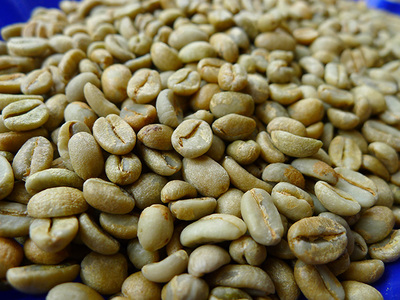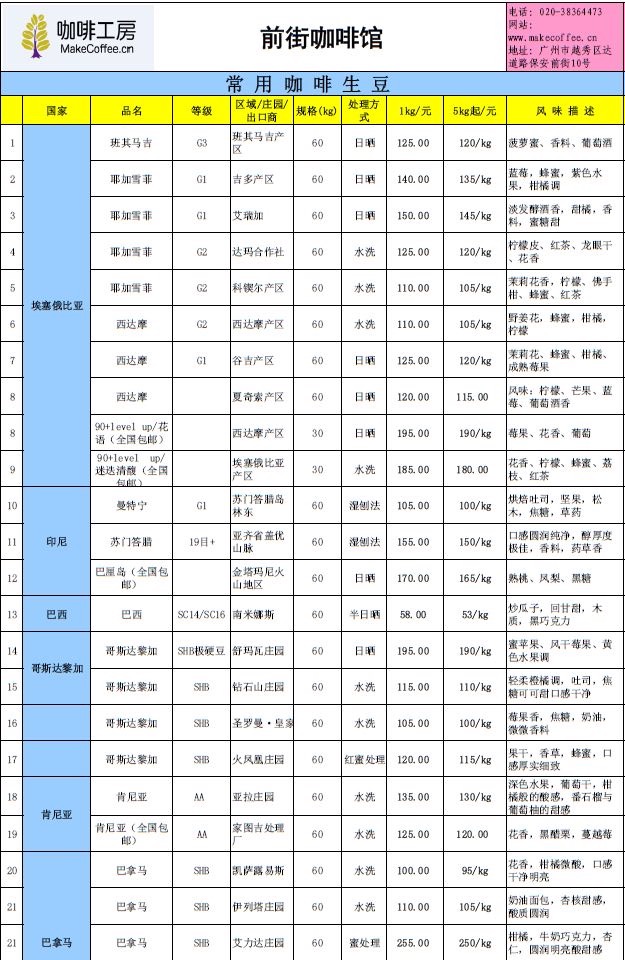Raw beans of Ethiopian Sidamo Coffee treated with Water washing G2 Grade imported Coffee unbaked beans
Arabica coffee trees still grow wild in large numbers in many parts of Ethiopia, averaging 4,200-6,800 feet above sea level. There is a trend towards small cultivation, usually with banana trees for shade, but due to lack of agricultural technology, herbicides and pesticides are used less.
Coffee is Ethiopia's main cash crop and the country's largest crop export and important industry, accounting for 60% of Ethiopia's total exports and supporting many small farms, as well as sugar, bananas, and cotton. it is also ethiopia's largest and most important commodity export crop after oil, and the largest african arabica seed export crop, with a total value of about us $300 million in 1997. in terms of total production, 94% is produced by small farms and 6% by government agencies, because many farms are scattered and also grow other crops, so it is difficult to accurately integrate the exact figures, but the country's official statistics show that the total coffee cultivation area is at least 400000 hectares. The Ethiopian government encourages local farmers to improve quality and productivity so that coffee farmers can expand their businesses, increase production capacity and export.
During harvest, farmers harvest bright red fruit every day, every two days into a unit of coffee fruit sent or sold to the washing plant treatment, not through the water treatment plant coffee fruit will usually be about 12 hours of natural fermentation, and then through the sun, so that drying and shelling, in any case, a little able farmers always try to send to the water treatment plant treatment, in order to crown "washing treatment" name and sell better prices, in the washing plant, Coffee cherries are soaked and fermented for about 12 hours to soften the pulp, then pass through the waterway and stir, so that the pulp and coffee beans are separated, the pulp is discharged with the gate, and the coffee beans need six days of sunshine drying treatment, but the treatment time is only from sunrise to 11:00 in the morning, and from 03:00 to sunset in the afternoon, the water content of the processed raw beans should be about 12%~12.5%; after selecting the residual beans or inferior beans, they are packed in sacks and sent to the coffee auction house in Addis Ababa, the capital by truck.
There are many water treatment plants along the main roads of coffee producing areas, especially in the Gima region. Many treatment plants are underutilized because of fierce competition, so the managers of treatment plants pay higher prices to farmers because of this, but they are worried about whether they can make a profit. Nowadays, a kilogram of raw beans usually sells for about 2 Birr (Ethiopian units); The daily capacity of each plant is approximately ten bags per day for two months of continuous work by plant employees without rest days throughout the harvest period.
There is a growing trend towards washing plants in Ethiopia. Smallholders sell their harvested coffee to the plants, shell it and resell it to auction systems, then transfer it to the Red Sea ports of Eritrea Assab and Djibouti near the Gulf of Aden. Although coffee is the country's main agricultural export, its annual consumption is staggering, accounting for about 1500000bags/60kg, accounting for 50% of total production. Wild coffee grows in the tropical rain forest of the southwest plateau, and most of them are hand-picked, but because of this, many local people have maliciously destroyed the naturally formed rainforest areas-or cut down or burned them to facilitate access to the rugged mountain areas, but they have seriously affected the ecological balance.
Whether washed or sun-dried, all exported coffee is sent to the capital city of Addis Ababa and the DIREDAWA auction outlet in Harrah province. DIREDAWA auction center usually exports sun-dried coffee from this area. Information on coffee from different farms can be seen daily in the auction hall to facilitate the acquisition of traders. Several officials from Ethiopia also enter this center daily to inspect and grade the coffee. Each time, the same batch of raw beans is randomly sampled for inspection.
Country: Ethiopia Fiscal year: 2003
Grade: G2
Production area: West Dharma production area
Treatment method: washing
Breed: Heirloom
Flavor: Wild ginger flower, honey, citrus, lemon

Important Notice :
前街咖啡 FrontStreet Coffee has moved to new addredd:
FrontStreet Coffee Address: 315,Donghua East Road,GuangZhou
Tel:020 38364473
- Prev

Raw bean wholesale price two new bean Vera plateau yellow bourbon varieties of high quality coffee in Huilan, Colombia
The history of Colombian coffee dates back to 1808. A priest brought coffee to Colombia for the first time from the French Antilles via Venezuela. The suitable climate in Colombia provides a real natural pasture for coffee. Since then, coffee trees have taken root in this country. The country has also become the second largest coffee producer after Brazil and the world's largest Arabica coffee.
- Next

Coffee raw bean price Ethiopian water wash Yega Xuefei boutique coffee raw bean Dama cooperative G2 level
There are eight major producing areas in Ethiopia: Ekempti, Limu, Illubabor, Djimma, Harrar, Teppi/Bebeka, Sidamo and Yirgacheffe. Yirgacheffe is located in the Gedeo region of southern Ethiopia, and the jurisdiction of this area is better known as Yegashafi and Kochere. Because of Yirgacheffe
Related
- Detailed explanation of Jadeite planting Land in Panamanian Jadeite Manor introduction to the grading system of Jadeite competitive bidding, Red bid, Green bid and Rose Summer
- Story of Coffee planting in Brenka region of Costa Rica Stonehenge Manor anaerobic heavy honey treatment of flavor mouth
- What's on the barrel of Blue Mountain Coffee beans?
- Can American coffee also pull flowers? How to use hot American style to pull out a good-looking pattern?
- Can you make a cold extract with coffee beans? What is the right proportion for cold-extracted coffee formula?
- Indonesian PWN Gold Mandrine Coffee Origin Features Flavor How to Chong? Mandolin coffee is American.
- A brief introduction to the flavor characteristics of Brazilian yellow bourbon coffee beans
- What is the effect of different water quality on the flavor of cold-extracted coffee? What kind of water is best for brewing coffee?
- Why do you think of Rose Summer whenever you mention Panamanian coffee?
- Introduction to the characteristics of authentic blue mountain coffee bean producing areas? What is the CIB Coffee Authority in Jamaica?

